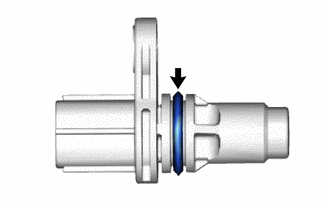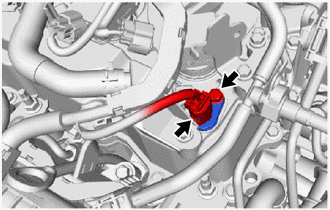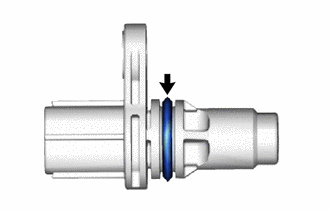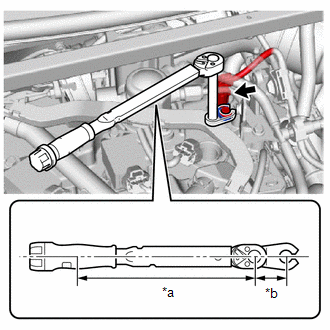Toyota Yaris: Camshaft Position Sensor / Installation
INSTALLATION
PROCEDURE
1. INSTALL CAMSHAFT POSITION SENSOR (for Intake Side)
| (a) Clean the O-ring groove of the camshaft position sensor. NOTICE: Make sure the O-ring groove is free of foreign matter. |
|
(b) Install a new O-ring to the camshaft position sensor.
NOTICE:
Set the O-ring on the tip of the camshaft position sensor and roll it into the O-ring groove with bare hands to install it.
(c) Check if the O-ring is twisted.
| (d) Install the camshaft position sensor to the cylinder head cover sub-assembly with a new bolt. Torque: 10 N·m {102 kgf·cm, 7 ft·lbf} NOTICE:
|
|
(e) Connect the camshaft position sensor connector.
2. INSTALL CAMSHAFT POSITION SENSOR (for Exhaust Side)
| (a) Clean the O-ring groove of the camshaft position sensor. NOTICE: Make sure the O-ring groove is free of foreign matter. |
|
(b) Install a new O-ring to the camshaft position sensor.
NOTICE:
Set the O-ring on the tip of the camshaft position sensor and roll it into the O-ring groove with bare hands to install it.
(c) Check if the O-ring is twisted.
| (d) Using a 10 mm union nut wrench, install the camshaft position sensor to the cylinder head cover sub-assembly with a new bolt. Torque: Specified Tightening Torque : 10 N·m {102 kgf·cm, 7 ft·lbf} NOTICE:
HINT:
|
|
(e) Connect the camshaft position sensor connector.
3. INSTALL IGNITION COIL ASSEMBLY
(a) Install the bolt and ignition coil assembly.
Torque:
10 N·m {102 kgf·cm}
(b) Connect the ignition coil assembly connector.
4. INSTALL ENGINE WIRE
(a) Install the bolt and engine wire.
Torque:
10 N·m {102 kgf·cm}
5. INSPECT FOR ENGINE OIL LEAK
Click here

 Removal
Removal
REMOVAL PROCEDURE 1. SEPARATE ENGINE WIRE (a) Remove the bolt and engine wire.
2. REMOVE IGNITION COIL ASSEMBLY (a) Disconnect the ignition coil assembly connector...
 Crankshaft Position Sensor
Crankshaft Position Sensor
ComponentsCOMPONENTS ILLUSTRATION
*1 CRANKSHAFT POSITION SENSOR *2 O-RING
Tightening torque for "Major areas involving basic vehicle performance such as moving/turning/stopping" : N*m (kgf*cm, ft...
Other information:
Toyota Yaris XP210 (2020-2025) Reapir and Service Manual: System Description
SYSTEM DESCRIPTION LIN COMMUNICATION SYSTEM DESCRIPTION The LIN communication system is used for communication between the components in the tables below. If communication cannot be performed through LIN communication such as when there is an open or short in a communication line, the master control ECU of the relevant system will store a DTC...
Toyota Yaris XP210 (2020-2025) Reapir and Service Manual: Adjustment
ADJUSTMENT CAUTION / NOTICE / HINT The necessary procedures (adjustment, calibration, initialization, or registration) that must be performed after completing the front wheel alignment procedure are shown below. Necessary Procedures After Procedure Performed Replacement Part or Procedure Necessary Procedure Effect/Inoperative when not Performed Link Front wheel alignment adjustment ECU Data Initialization Active torque split AWD system Calibration DTCs are stored Slip indicator light illuminates VSC disabled or malfunctions PROCEDURE 1...
Categories
- Manuals Home
- Toyota Yaris Owners Manual
- Toyota Yaris Service Manual
- Opening and Closing the Liftgate/Trunk Lid
- How to connect USB port/Auxiliary jack
- Diagnostic Trouble Code Chart
- New on site
- Most important about car
Front Seat Belt Pretensioners
The front seat belt pretensioners are designed to deploy in moderate or severe frontal, near frontal collisions.
In addition, the pretensioners operate when a side collision or a rollover accident is detected. The pretensioners operate differently depending on what types of air bags are equipped. For more details about the seat belt pretensioner operation, refer to the SRS Air Bag Deployment Criteria.





